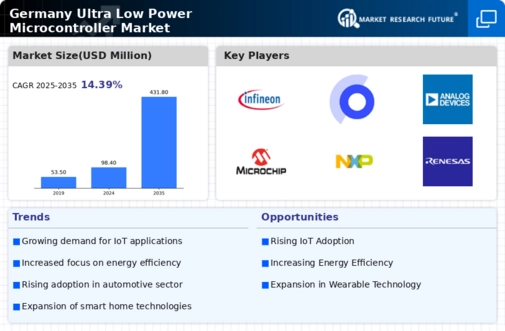Growing Adoption of Smart Devices
The increasing prevalence of smart devices in various sectors drives the ultra low-power microcontroller market. This includes sectors such as healthcare, automotive, and consumer electronics. In Germany, the smart home market is projected to reach €10 billion by 2025, indicating a robust demand for energy-efficient microcontrollers. These devices require microcontrollers that can operate efficiently with minimal power consumption, thus enhancing battery life and overall performance. As consumers become more environmentally conscious, the need for sustainable technology solutions becomes paramount. This trend suggests that manufacturers focusing on ultra low-power microcontrollers will likely gain a competitive edge in the market. Furthermore, the integration of these microcontrollers into smart devices aligns with Germany's commitment to innovation and sustainability, potentially leading to increased investments in research and development within the ultra low-power-microcontroller market.
Rising Focus on Wearable Technology
The burgeoning wearable technology sector in Germany significantly influences the ultra low-power-microcontroller market. With the market for wearables projected to reach €5 billion by 2025, there is a growing need for microcontrollers that can operate efficiently in compact devices. Wearables, such as fitness trackers and smartwatches, require ultra low-power microcontrollers to ensure prolonged battery life and seamless performance. This trend suggests that manufacturers are likely to prioritize the development of microcontrollers tailored for wearable applications, which often demand high levels of integration and energy efficiency. As consumer interest in health and fitness continues to rise, the ultra low-power-microcontroller market is expected to benefit from increased investments in this segment, driving innovation and enhancing product offerings.
Emergence of Smart Grid Technologies
The emergence of smart grid technologies in Germany presents a significant opportunity for the ultra low-power-microcontroller market. As the country transitions towards renewable energy sources, the need for efficient energy management systems becomes critical. Ultra low-power microcontrollers play a vital role in smart grid applications, enabling real-time monitoring and control of energy consumption. The German government has set ambitious targets for renewable energy, aiming for 65% of electricity consumption to come from renewable sources by 2030. This shift necessitates the integration of advanced microcontrollers in energy management systems to optimize performance and reduce waste. The potential for smart grid technologies to enhance energy efficiency and reliability indicates a promising growth trajectory for the ultra low-power-microcontroller market, as stakeholders seek innovative solutions to meet evolving energy demands.
Regulatory Support for Energy Efficiency
Germany's stringent regulations aimed at promoting energy efficiency significantly impact the ultra low-power-microcontroller market. The government has implemented various policies to encourage the adoption of energy-saving technologies across industries. For instance, the Energy Efficiency Act mandates that companies reduce their energy consumption by 20% by 2025. This regulatory environment fosters a demand for ultra low-power microcontrollers, as they are essential for developing energy-efficient products. Manufacturers are increasingly investing in R&D to create microcontrollers that comply with these regulations while meeting performance standards. The potential for financial incentives for companies adopting energy-efficient technologies further stimulates growth in the ultra low-power-microcontroller market. As a result, the alignment of regulatory frameworks with market needs creates a conducive environment for innovation and expansion in this sector.
Advancements in Wireless Communication Technologies
The rapid advancements in wireless communication technologies, such as 5G and LPWAN, are reshaping the ultra low-power-microcontroller market. In Germany, the rollout of 5G networks is expected to enhance connectivity for IoT devices, which rely heavily on ultra low-power microcontrollers for efficient operation. These microcontrollers are designed to support low-power wireless communication, enabling devices to transmit data with minimal energy consumption. The increasing demand for connected devices in sectors like smart cities and industrial automation further propels the need for advanced microcontrollers. As companies seek to leverage the benefits of 5G, the ultra low-power-microcontroller market is likely to experience substantial growth. This trend indicates a shift towards more sophisticated microcontroller solutions that can handle the demands of next-generation wireless communication while maintaining energy efficiency.























Leave a Comment